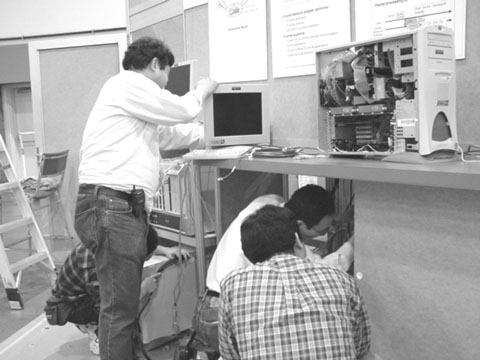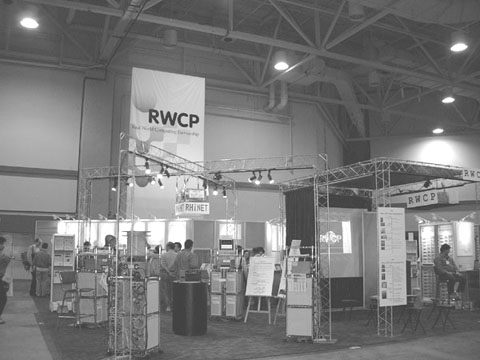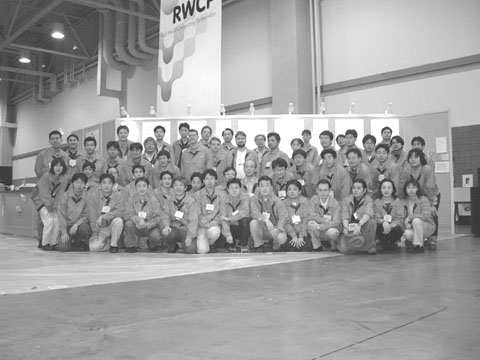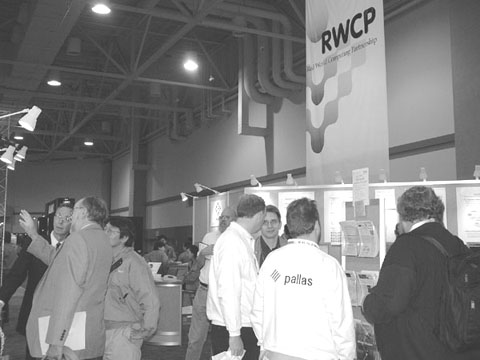
Staff members preparing the booth
The SC is a typical international conference on high-performance computing that is held annually in November. The SC 2000 (Supercomputing 2000) was held in Dallas, Texas, from November 4 through 10. A number of tutorial sessions and paper presentations attracted many researchers and professionals active in their respective fields. Among the programs, the exhibition by research institutes and private companies from many countries is the main event of the conference. The SC exhibition consisted of general exhibitions by private companies and research exhibitions by institutes. In addition, the SC 2000 provided a ³VentureVillage² where newly established venture businesses were given a place to present exhibits, reflecting the increasingly important role of venture businesses in the high-performance computing industry. Ten ventures took part in the SC 2000; it will be interesting to see if any of them becomes a key player in the future.
The Real World Computing Partnership (RWCP) has been continuously participating in the Supercomputing Conference since 1996. In addition to the RWCP Tsukuba Research Center, five distributed laboratories joined the SC 2000: Optical Interconnection Hitachi, Parallel Applications Toshiba, Parallel and Distributed Systems GMD, Parallel and Distributed Systems NEC, and Parallel and Distributed Systems Fujitsu Laboratories. Nearly 60 people, including some members from the headquarters in Tokyo, jointly prepared and provided the RWCP presentation. The RWCP obtained a relatively large exhibition space for a research institute. Though it was located far from the main entrance, the 12-meter-by-12-meter booth always attracted many visitors. And our giveaways, cloth bags printed with the RWCP logo and containing leaflets and other materials, disappeared almost immediately they were put on the reception counter, and our staff were kept busy restocking them. During the exhibition, I saw many people holding the bag throughout the venue. Paper fans or uchiwa, another handout item, were also very popular and our stock for the event was not sufficient. Some people came to our booth just for the giveaways. However, they were certainly a ³good bait² to attract people who had little knowledge about the RWCP to visit our booth.

The main exhibit of our booth was SCore Cluster II, a 128-processor cluster system. Very few participants, including private companies, exhibited and operated a cluster system comparable in scale to our machine. Additionally, we displayed and provided demonstrations of a 16-node cluster system linked with a high-speed network RHiNET and a 5-node cluster system consisting of IP/OC48c. Our exhibition appeared to outclass other cluster system exhibits, and it was certainly interesting for visitors to see cluster systems in operation. Our ³presentation theater,² a new experiment for this year's SC, was also popular among visitors.
The Parallel and Distributed Systems Fujitsu Laboratory (the organization to which I belong) took part in the conference for the first time in 1998 and the SC 2000 was its second appearance. This time, the Fujitsu Lab demonstrated a cluster system that consisted of IP/OC48c using a Comet network adapter that allows for higher-speed networking. During the exhibition, representatives from several companies came to our booth and asked for more information on the system as they said they wanted to use our technology for their product. Such a reaction is surely possible only at a major exhibition like the SC.


The net duration of the SC 2000 exhibition was only three days as it started Monday evening (November 6) and ended on Thursday (November 9). The hardest part was, however, the preparations prior to the event. Most of our members arrived at Dallas more than three days before the conference date and began constructing the booth and preparing the exhibit. If we had been in Japan, we could have had a three-day consecutive holiday because November 3 was Culture Day, national holiday. We were lucky that no big problems arose during the preparation work and most of our staff members could have a day-off on Sunday. All materials and equipment were delivered in large wooden boxes ... it was quite time-consuming to unpack the containers, take out the materials and equipment, place and install them, and prepare for the demonstration. In particular, unloading and installing the SCore Cluster II was really troublesome. Although the RWCP staff are accustomed to doing it every year, it was very impressive to see their skilled work. This time, I arrived at Dallas on Thursday (November 2) as a member of the later-departing group, so the unpacking was almost finished and each laboratory group had started their own preparations by the time I reached the exhibition site. Immediately after arrival, I joined them in the equipment installation and cabling work. When some PCs didn't start working, we solved the trouble by taking out several boards and reinserting them. I was responsible for software and found that we didn't have the latest drivers when we were about to install programs. We had no option but to go back to the hotel that evening, so from my hotel room I accessed the Internet and downloaded all the necessary software to my PC. From the following day on, we didn't face any major trouble. Other laboratory groups also finished preparations without a hitch. On Monday morning, our booth was completely ready for the opening of the exhibition.


A meal after much hard work always tastes especially good. What's more, if it's a local specialty of the place you're visiting, nothing else tastes better. One of our senior members said that he had found a nice local restaurant serving excellent lobsters. ³Yes, it must be the lobster season as it is getting colder,² I thought. But Maine is the place you have to go for lobsters. Have you ever heard of Dallas lobsters? The senior member told us that the Gulf of Mexico was a great lobster fishery, and that he'd seen many Gulf lobsters in a local TV program. So with high hopes of Dallas lobsters we went to the local restaurant. There were glass tanks containing a number of lobsters near the entrance, and as we pointed to them, a restaurant staff picked them out and took them to the kitchen for boiling. The lobsters were absolutely delicious, even for lobsters in Dallas! "Where did they catch these lobsters?" I asked.
"Well, maybe somewhere up in Alaska, I guess," said the waiter.
So, I still don't know if Gulf lobsters are really good.
The SC 2000 was a great success. I regretted that I didn't have much time to attend paper presentations and other sessions because I participated in the event as an exhibitor. But the real pleasure of exhibitors is that their exhibit is exposed to the eyes of numerous visitors, so I was highly satisfied in that sense. But the real reason why our exhibition at SC 2000 was successful and we had opportunities to meet many researchers was the support and assistance from so many people. I'd like to thank everyone concerned.